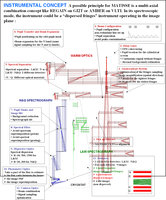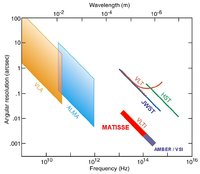MATISSE Concept
The first generation of VLTI (Very Large Telescopes Interferometer) focal instruments, AMBER in the near-infrared and MIDI in the mid-infrared, has been already integrated and tested. New and important science results have been obtained. These instruments combine two (for MIDI) or three (for AMBER) beams coming from the eight telescopes installed at Cerro Paranal (four 8-meters and four/five 1.8-meters telescopes).
In order to improve the capabilities of the interferometer and to engage a new scientific prospective, the second generation of VLTI instruments is currently under study. MATISSE (Multi-AperTure mid-Infrared SpectroScopic Experiment) belongs to this second generation. MATISSE objective is the image reconstruction. It will extend the astrophysical potential of the VLTI by overcoming the ambiguities existing in the interpretation of simple visibility measurements. It is a spectro-interferometer combining up to four beams with a large spectral coverage ranging from 3 to 13 µm (L, M, and N bands). Different spectral resolutions (between 30 and 1500) are foreseen. MATISSE will measure closure phase relations thus offering an efficient capability for image reconstruction. A possible recombination mode of MATISSE is similar to the AMBER beam combination, but has been adapted to the constraints specific to the mid-infrared domain.
General Instrumental Specifications
| Characteristics | Requirements |
| Number of combined beams (from AT or UT) | 4 (2 or 3 beam combination allowed) |
| Spectral coverage | L, M, and N bands (3-25 µm), Q band has been investigated but not retained in the final concept |
| Number of combined beams in spectroscopic mode | Specification: 3 Goal: 4 |
| Simultaneous spectral bands | L&M and N |
| Spectral resolutions | R=30, R=500, R=1500-2000 for L&M R=30, R=300 for N |
| Sensitivity (After 15 min of observation with R=30) | 0.1 Jy with UTs for N 0.01 Jy with UTs for L&M |




